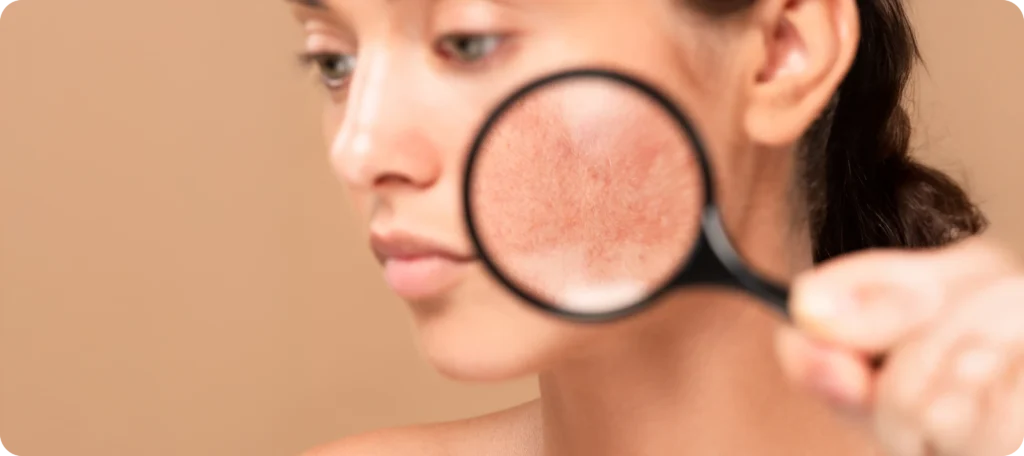Have you ever paused to think about what might actually be living on your skin? If so, you’re not alone and no, it’s not your imagination. Your skin is teeming with life. In fact, it’s home to a vast and complex community of microscopic organisms, collectively known as the skin microbiome. This invisible yet vital ecosystem consists of billions of bacteria, fungi, viruses, and even tiny mites. Together, they create a delicate balance that plays a crucial role in keeping your skin healthy, resilient, and protected.
While these tiny inhabitants may sound unsettling, most of them are not only harmless but actually beneficial. They help defend your skin against harmful invaders, regulate inflammation, and even support your skin’s natural barrier. However, when this balance is disrupted due to environmental factors, skincare products, diet, or stress it can contribute to a variety of skin concerns.
In this guide, we’ll take a deep dive into the skin microbiome: what it is, how it impacts different skin conditions, what causes imbalances, and most importantly what steps you can take to nurture and maintain a healthy skin ecosystem.
What Exactly Is the Skin Microbiome?
Imagine your skin microbiome as a vast, invisible army of microbial bodyguards working around the clock to protect, balance, and strengthen your skin. This army includes a diverse mix of bacteria, fungi, viruses, and microscopic mites that reside not only on the surface of your skin but also deep within your pores, creases, and follicles.
Far from being harmful, most of these tiny organisms play essential roles in defending against harmful pathogens, regulating inflammation, maintaining pH balance, and reinforcing your skin’s protective barrier. Think of them as a built-in defines system that keeps your skin functioning at its best.
What makes it even more fascinating is that your skin microbiome is entirely unique to you, like a microbial fingerprint. It’s shaped by a wide variety of factors, including your age, genetics, environment, diet, stress levels, hormonal changes, and even the products you use in your daily skincare routine.
Understanding and nurturing your skin microbiome is a powerful step toward achieving long-term skin health, not just short-term fixes.
How the Microbiome Affects Acne
Acne is often thought of as a simple mix of excess oil, clogged pores, and hormonal changes but there’s a deeper story involving your skin’s microbiome. One of the key players in acne is a type of bacteria called Cut bacterium acnes (formerly known as Propionibacterium acnes). This bacterium naturally lives on everyone’s skin and, in normal amounts, it doesn’t cause any harm. In fact, it’s part of a healthy microbial community.
However, problems begin when this bacterium starts to multiply excessively, especially in oily or congested areas. When overgrowth occurs, C. acnes can trigger your immune system to respond with inflammation, leading to redness, swelling, and the formation of pimples.
Such disruptions can create an environment where harmful bacteria flourish, ultimately worsening acne rather than clearing it. That’s why many dermatologists and skincare experts are now advocating for gentle, microbiome-friendly routines that prioritize barrier protection over aggressive treatment.
From probiotic serums to pH-balanced cleansers, the future of acne care is shifting toward nurturing the skin’s natural defences not fighting them.
Rosacea and Skin Microbes: What’s the Connection?

Rosacea is a chronic and often misunderstood skin condition, marked by symptoms like persistent redness, visible blood vessels, bumps, and skin sensitivity especially on the cheeks, nose, chin, and forehead. While triggers such as heat, stress, spicy food, and alcohol are commonly known, there’s growing evidence that the skin microbiome particularly the presence of microscopic mites and bacteria may play a more important role than previously thought.
One of the key players in this microbial puzzle is a tiny mite called Demodex. These mites are naturally present on everyone’s skin, usually living harmlessly inside our hair follicles. But research shows that individuals with rosacea often have higher-than-normal populations of Demodex mites.
Here’s where it gets interesting:
- Demodex mites can carry bacteria especially one called Bacillusloeries that may trigger an inflammatory response in sensitive skin.
- This bacterial overactivity, paired with the immune system’s hypersensitivity in rosacea patients, may lead to increased redness, swelling, and breakouts.
- A disrupted microbiome may further weaken the skin barrier, making it more reactive to environmental stressors and further worsening rosacea symptoms.
While the exact relationship between microbes and rosacea is still being unravelled, early studies suggest that addressing microbial imbalances could be key to reducing flare-ups and improving skin resilience.
If you’re dealing with persistent redness, bumps, or sensitivity, it’s worth talking to a dermatologist. They may recommend treatments such as:
- Topical or oral medications that reduce Demodex populations
- Microbiome-supportive skincare, like gentle, non-irritating cleansers
- Laser treatments or light therapy to calm inflammation
- Barrier-repair creams that help restore balance and soothe reactive skin
As research evolves, rosacea care is shifting from symptom control to root-cause management, with the skin microbiome at the centre of this new approach.
Eczema and the Loss of Microbial Diversity
Eczema, also known as atopic dermatitis, is a chronic inflammatory skin condition that causes dryness, redness, itching, and sensitivity. While genetics, environmental triggers, and immune dysfunction play key roles, there’s growing awareness that an imbalance in the skin microbiome especially a loss of microbial diversity is a major contributor to eczema flare-ups.
Here’s how this microbial imbalance affects eczema-prone skin:
- Reduced microbial diversity weakens the skin’s natural defences, making it easier for irritants, allergens, and bacteria to penetrate.
- Staphylococcus aureus overgrowth can trigger and worsen inflammation, leading to red, itchy, and painful patches.
- The resulting irritation often causes scratching, which damages the skin further and disrupts the barrier, creating a vicious cycle.
Fortunately, there are ways to support the skin’s microbiome and restore a healthier balance:
- Use gentle, fragrance-free skincare products to avoid further irritation
- Apply rich moisturizers regularly to strengthen the skin barrier and lock in hydration
- Consider prescription treatments like antimicrobial creams or steroid ointments during flare-ups
- New research is also exploring probiotic and microbiome-friendly skincare, which may help rebalance bacteria and reduce inflammation
By focusing not just on relieving symptoms, but also on rebuilding microbial diversity and protecting the skin barrier, eczema management is evolving into a more targeted and long-term approach.
What Disrupts Your Microbiome?

Your skin microbiome may be invisible to the naked eye, but it’s incredibly sensitive and surprisingly easy to disrupt. While your skin does an impressive job of maintaining its own balance, everyday habits and environmental factors can throw this delicate ecosystem off course, often without you even realizing it.
Disruptions to the microbiome can cause a decline in beneficial microbes and a rise in harmful bacteria, which may lead to inflammation, sensitivity, breakouts, dryness, and other skin conditions. Understanding these triggers can help you protect your skin’s natural defenses.
Here are the most common culprits:
1. Over-Cleansing and Harsh Soaps
- Using strong cleansers, antibacterial soaps, or washing your face too often can strip the skin of its natural oils and good bacteria.
- This makes your skin more vulnerable to pathogens, dryness, and irritation.
- Opt for gentle, pH-balanced cleansers that cleanse without over-stripping.
2. Frequent Product Switching
- Constantly trying new skincare products can confuse your skin and disrupt its microbial balance.
- Many formulas contain preservatives or active ingredients that may be too harsh when overused.
- Stick to a consistent, minimalist routine tailored to your skin type.
3. Environmental Stressors
- Air pollution can introduce toxic particles to the skin, affecting microbial balance and increasing inflammation.
- UV radiation from the sun not only damages skin cells but can also alter the composition of your skin’s microbiome.
- Combat these with antioxidant-rich skincare and daily sun protection (SPF 30 or higher).
4. Stress and Sleep Deprivation
- Chronic stress impacts the immune system and alters hormone levels, which can disrupt the microbiome and lead to flare-ups.
- Poor sleep interferes with the body’s ability to repair the skin and maintain microbial balance.
- Support your microbiome with regular sleep, stress-reducing habits, and mindful self-care.
5. Poor Diet and Dehydration
- A diet high in sugar, processed foods, and unhealthy fats can contribute to internal inflammation, which may reflect on your skin.
- Lack of hydration can reduce the skin’s ability to maintain a healthy barrier, weakening its microbial defenses.
- Eat a balanced diet rich in fruits, vegetables, healthy fats, and fermented foods to nourish your body and skin from within.
6. Overuse of Antibiotics (Topical or Oral)
- While sometimes necessary, frequent or long-term antibiotic use can wipe out both harmful and beneficial bacteria.
- This creates space for opportunistic microbes to overgrow, increasing the risk of infections or flare-ups.
- If you’re on antibiotics, talk to your doctor about supportive probiotics or alternative treatments.
How to Support a Healthy Microbiome
If you’re looking to build healthier, more resilient skin, supporting your skin microbiome is one of the most impactful things you can do. The good news? It doesn’t require a 10-step skincare routine or expensive treatments. In fact, nurturing your microbiome is often more about simplifying your habits rather than complicating them.
Below are some science-backed, practical ways to help your microbiome flourish and protect your skin from within:
1. Simplify Your Skincare Routine
- Using too many products especially those with strong acids, alcohol, or fragrances can strip your skin of the beneficial microbes it needs to thrive.
- Keep your routine minimal and focus on gentle, nourishing products that support the skin barrier instead of disrupting it.
- Stick to the basics: a gentle cleanser, a hydrating moisturizer, and a broad-spectrum sunscreen during the day.
2. Choose Microbiome-Friendly Products
- Look for skincare labelled with terms like:
- “pH-balanced” – helps maintain the natural acidity that good microbes love
- “Soap-free” – avoids harsh detergents that can disturb microbial balance
- “Prebiotic,” “Probiotic,” or “Postbiotic” – supports good bacteria and enhances skin resilience
- Avoid ingredients like sulphates, synthetic fragrances, and harsh preservatives, which can disrupt the microbiome.
3. Be Gentle with Cleansing
- Over-washing your face or using hot water and scrubs can strip away protective oils and beneficial bacteria.
- Aim to wash your face no more than twice a day (morning and night) with lukewarm water and a gentle cleanser.
- Skip harsh exfoliators especially physical scrubs and instead use mild chemical exfoliants sparingly if needed.
4. Prioritize a Gut-Healthy Diet
- Your gut and skin are connected through the gut-skin axis meaning what you eat has a direct impact on your skin’s microbiome.
- Eat foods rich in:
- Dietary fibre – feeds beneficial gut bacteria
- Fresh fruits and vegetables – loaded with antioxidants and vitamins
- Fermented foods like yogurt, kefir, kimchi, or sauerkraut – provide natural probiotics
- Plenty of water – keeps your skin hydrated and functioning properly
- Minimize sugar, processed foods, and excess dairy, which may contribute to inflammation and imbalance.
5. Get Enough Rest and Manage Stress
- Chronic stress and sleep deprivation can disrupt your immune system and microbiome balance, making your skin more prone to breakouts and irritation.
- Make space for regular sleep, mindful relaxation, and activities that help your de-stress, such as walking, reading, or meditation.
Can You Test Your Skin Microbiome?
Absolutely testing your skin microbiome is now possible thanks to advances in dermatological science and biotechnology. While it might sound like something out of a science lab, at-home test kits and clinical assessments are becoming more accessible for individuals who want to better understand their skin from a microscopic perspective.
These tests work by analysing the microorganisms bacteria, fungi, viruses, and mites that live on the surface of your skin. They typically involve swabbing specific areas of the skin and sending the sample to a lab for DNA sequencing and microbial analysis.
Who Should Consider Microbiome Testing?
While microbiome testing isn’t necessary for everyone, it can be incredibly useful if you:
- Are dealing with chronic or unexplained skin issues like acne, eczema, rosacea, or extreme sensitivity
- Have tried multiple treatments without long-term success
- Are interested in a personalized skincare approach based on your skin’s unique microbial composition
- Want to understand how lifestyle factors like diet, environment, or product use are affecting your skin health
What Do These Tests Reveal?
Microbiome tests can provide detailed insights into:
- The diversity and balance of microbes living on your skin
- The presence of beneficial vs. harmful bacteria
- Whether specific strains of bacteria or fungi are overrepresented or underrepresented
- How your skin’s microbial profile compares to healthy benchmarks
This data can help dermatologists or skincare professionals recommend targeted solutions that align with your skin’s specific needs whether that’s adjusting your skincare routine, addressing gut health, or even applying topical probiotics.
Treatments That Protect the Microbiome

As our understanding of the skin microbiome grows, modern dermatology is rapidly evolving to incorporate approaches that protect and support this vital ecosystem. Traditional treatments often focused solely on eliminating visible symptoms like inflammation, acne, or redness without considering the delicate microbial balance beneath the surface. Today, however, the trend is shifting toward gentler, microbiome-conscious care that aims for long-term skin health, not just short-term relief.
At progressive clinics like The London Dermatology Centre, we design treatment plans with your microbiome in mind choosing therapies that heal and restore rather than disrupt.
Microbiome-Friendly Treatment Options
Here are some examples of how dermatology is adapting to preserve and support the skin’s natural microbial harmony:
1. Topical Probiotics and Prebiotics
- These products contain beneficial bacteria (probiotics) or nutrients that support good bacteria (prebiotics), helping restore microbial balance.
- Especially useful in managing conditions like acne, eczema, and rosacea, probiotic creams may reduce inflammation and prevent the overgrowth of harmful microbes.
2. Barrier-Repair Creams
- These creams are designed to strengthen the skin’s natural barrier, which is essential for keeping your microbiome intact.
- Ingredients like ceramides, hyaluronic acid, squalane, and niacinamide can soothe irritation, lock in moisture, and support a stable microbial environment.
3. LED Light Therapy
- Non-invasive treatments like blue or red-light therapy can reduce inflammation, kill harmful bacteria, and improve skin tone without damaging the microbiome.
- A safe and gentle option for those with acne or rosacea, this treatment doesn’t rely on harsh chemicals or antibiotics.
4. Mild Prescription Treatments
- When medication is necessary, we choose formulations that are effective yet microbiome-safe avoiding unnecessary use of strong antibiotics or steroids that can wipe out beneficial microbes.
5. Personalized Skincare Plans
- Based on skin analysis or microbiome testing, we craft individualized skincare routines that work with your skin’s biology, not against it.
- The focus is on consistency, protection, and gentle support, rather than quick fixes that could lead to long-term imbalance.
Final Thoughts: Your Microbiome Deserves Respect
It’s fascinating how much your skin’s invisible ecosystem shapes your overall skin health. Understanding and respecting your microbiome is key to treating chronic issues like acne, eczema, and rosacea more effectively.
If you’re not sure where to start, you can get in touch with us to book a consultation with one of our expert dermatologists. We’ll help you uncover what’s really happening beneath the surface and how to restore balance from the inside out.
References:
- Acne Vulgaris, Atopic Dermatitis and Rosacea: The Role of the Skin Microbiota (2022). Review highlighting microbial imbalances in acne, eczema, and rosacea. PubMed Central. Available at: https://pubmed.ncbi.nlm.nih.gov/36289784/
- The Role of the Skin Microbiome in Acne: Challenges and Future (2024). International Journal of Molecular Sciences. Available at: https://pubmed.ncbi.nlm.nih.gov/39518974/
- MIT News (2023). Scientists track evolution of microbes on the skin’s surface. MIT News. Available at: https://hst.mit.edu/news-events/scientists-track-evolution-microbes-skins-surface
- Frontiers in Microbiology (2023). Rosacea, microbiome and probiotics: the gut–skin axis. Available at: https://www.frontiersin.org/journals/microbiology/articles/10.3389/fmicb.2023.1323644/full
- PMC (2023). Crosstalk between skin microbiota and immune system in health and disease. Available at: https://www.ncbi.nlm.nih.gov/pmc/articles/PMC10247537/
